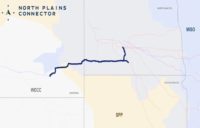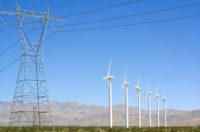Giant utility Pacific Gas and Electric Co. (PG&E) moving ahead on an effort to bury about 10,000 miles of electric distribution power lines in a multiyear program to reduce fire risk in its highest-threat areas of service in northern and central California. The utility company says the undergrounding initiative is the largest such U.S. effort as a wildfire risk reduction measure.
Although there had been media reports of PG&E resisting broad-scope line burial because of its expense, the utility said July 21 it has now committed to a program estimated to cost at least $15 billion to $20 billion. The 10,000 miles is about 12% of the company’s overhead power line total.
Utility CEO Patricia Poppe, who joined in January, said “We cannot put a price on the risk reduction and safety of our system.” She added, "We have taken a stand that catastrophic wildfires shall stop. We will partner with the best and the brightest to bring that stand to life."
She points to anticipated savings from economies of scale and reduced tree management costs.
"The ambitiousness of this level of buried cable is hard to understate, not to mention its cost and substantial permitting pitfalls, and as a result should not be considered feasible or realistic, in our view," says Andrew Wittmann, lead industrial services sector analyst for Baird Equity Research. "Still, in a sector where we've routinely pointed to strong drivers, we can add this one to the list, even if dramatically scaled down."
Wittmann says "this level of buried transmission line is unprecedented," adding that "for greater context, the entire United States spends just over $20 billion annually on the transmission grid."
PG&E also said in a new state regulatory filing that its equipment may have started the Dixie Fire last month, which has burned 192,000 acres in northern California. More than 16,000 people were still under evacuation orders in Plumas and Butte counties as of late July, reports say.
The exact number of projects or miles undergrounded each year will evolve as PG&E performs project scoping and inspections, estimating and engineering review, says spokesperson Ari Vanrenen. He says the utility has been able to “refine” construction and cost requirements.
Undergrounding also benefits customers by lessening need for Public Safety Power Shutoff events, says Vanrenen. PG&E is currently reviewing project sites for factors such as local municipal planning and safety considerations. Engineering an underground electric system requires designing it around existing water, natural gas and drainage systems, as well as planning for future road widening, he says. Vanrenen adds that this work will be focused within the Tier 2 and Tier 3 high-fire- threat districts of PG&E’s system.
According to Wittmann, "this type of investmen would vastly increase rates for customers." He emphsizes that "in a world where environmental permitting is more challenging than ever with multiple often conflicting agencies needed for approval, just the technical approval process alone would be extremely burdensome."
The utility says it has completed multiple demonstration undergrounding projects in preparation for the massive undertaking. Its initial undergrounding for system hardening projects began in 2018 in areas such as Butte County, site of the deadly Camp Fire, says Vanrenen. “These projects are showing us where we can be more efficient, and we can leverage the experience we have with undergrounding our gas assets for decades.”
According to Vanrenen, PG&E’s undergrounding is becoming more cost effective thanks to new technology such as chain and wheel trenchers to boost trench production, and adoption of directional boring. Utility crews are also testing new cable and conduit materials to speed up the construction process, he says.
Following the disastrous October 2017 northern California wildfires and the 2018 Camp Fire, PG&E says it began evaluating burial of overhead power lines as a wildfire safety measure and to better understand construction and cost requirements for system hardening purposes. The demonstration projects were part of PG&E’s community wildfire safety program.
While Baird's Wittmann says the PG&E annuncement "is a positive" in outlining "issues that are being faced and the measures that are being considered .... In reality it is hard to say it is incremental against already known and very high grid capex investment needs."







Post a comment to this article
Report Abusive Comment